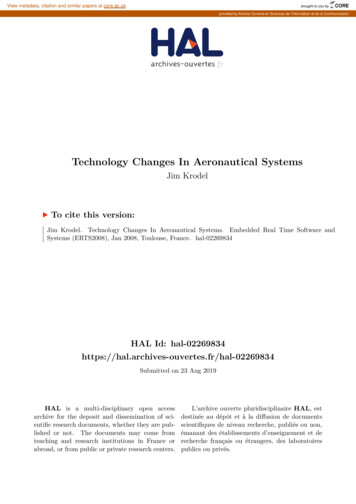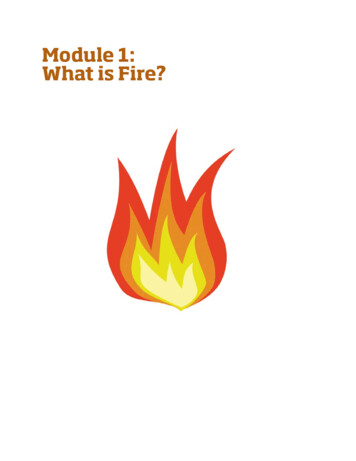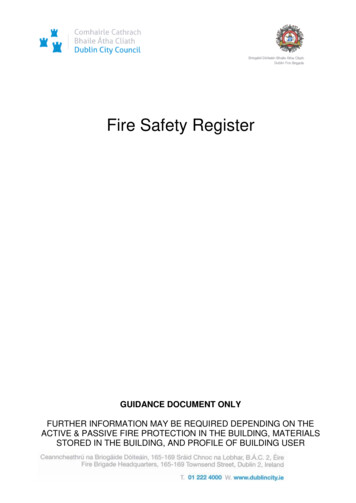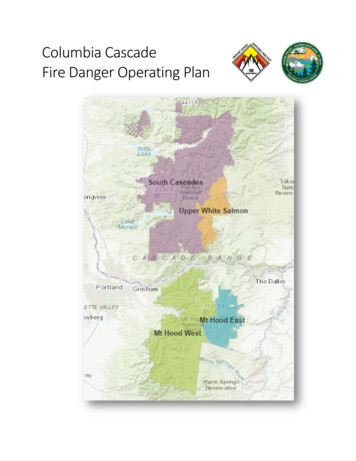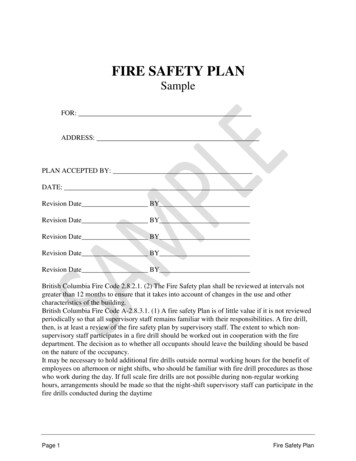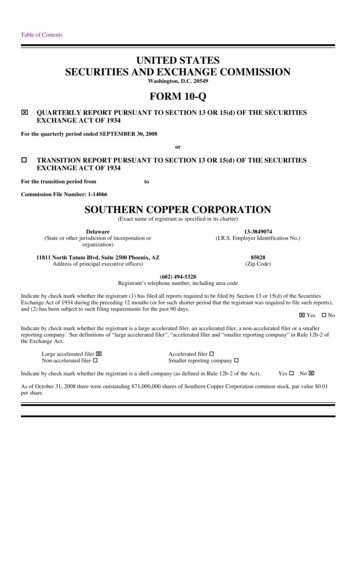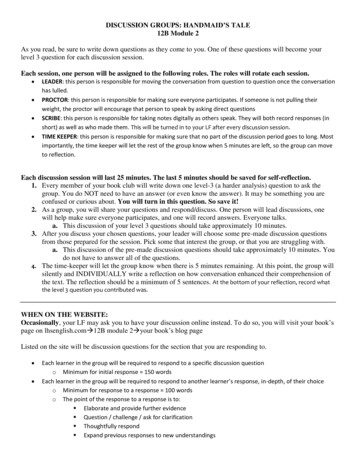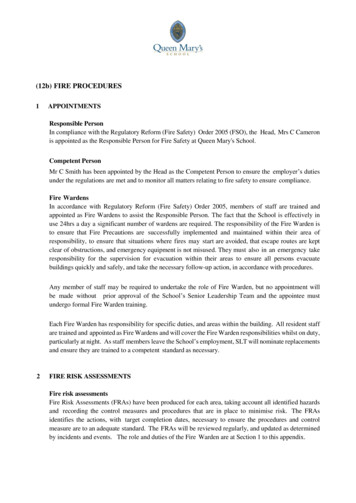
Transcription
Policy A11(12b) FIRE PROCEDURES1APPOINTMENTSResponsible PersonIn compliance with the Regulatory Reform (Fire Safety) Order 2005 (FSO), the Head, Mrs C Cameronis appointed as the Responsible Person for Fire Safety at Queen Mary's School.Competent PersonMr C Smith has been appointed by the Head as the Competent Person to ensure the employer’s dutiesunder the regulations are met and to monitor all matters relating to fire safety to ensure compliance.Fire WardensIn accordance with Regulatory Reform (Fire Safety) Order 2005, members of staff are trained andappointed as Fire Wardens to assist the Responsible Person. The fact that the School is effectively inuse 24hrs a day a significant number of wardens are required. The responsibility of the Fire Warden isto ensure that Fire Precautions are successfully implemented and maintained within their area ofresponsibility, to ensure that situations where fires may start are avoided, that escape routes are keptclear of obstructions, and emergency equipment is not misused. They must also in an emergency takeresponsibility for the supervision for evacuation within their areas to ensure all persons evacuatebuildings quickly and safely, and take the necessary follow-up action, in accordance with procedures.Any member of staff may be required to undertake the role of Fire Warden, but no appointment willbe made without prior approval of the School’s Senior Leadership Team and the appointee mustundergo formal Fire Warden training.Each Fire Warden has responsibility for specific duties, and areas within the building. All resident staffare trained and appointed as Fire Wardens and will cover the Fire Warden responsibilities whilst on duty,particularly at night. As staff members leave the School’s employment, SLT will nominate replacementsand ensure they are trained to a competent standard as necessary.2FIRE RISK ASSESSMENTSFire risk assessmentsFire Risk Assessments (FRAs) have been produced for each area, taking account all identified hazardsand recording the control measures and procedures that are in place to minimise risk. The FRAsidentifies the actions, with target completion dates, necessary to ensure the procedures and controlmeasure are to an adequate standard. The FRAs will be reviewed regularly, and updated as determinedby incidents and events. The role and duties of the Fire Warden are at Section 1 to this appendix.
Policy A113INSTALLED FIRE ALARM SYSTEMSFire AlarmsIn accordance with current standards, the whole school has an addressable fire alarm systems installed.The Main School Fire Alarm Panel is situated in the corridor opposite the rear entrance from thecourtyard. Zone layout plans and system log books are positioned adjacent to the fire alarm panel in theFire Control Grab Bag. The alarm system is not linked to the Fire and Emergency Services; they mustbe called to summon them once a fire is detected, either by the Red Direct Call Phone opposite the firepanel or mobile.Weekly Maintenance and TestingIn accordance with BS5389 Part 1:2002 all Fire Alarm Systems are tested weekly by Estate Staff onMonday’s between 10.15hrs and 10.30hrs. A record of the test is entered into the Log Book which issituated in the Main School Office. Defects detected at this time are entered into the Log Book andreported to the Estate Manager.Half Annual / Annual Maintenance and InspectionIn accordance with BS5839 Part 1:2002 the Alarm Systems are inspected every 6 months, culminatingwith the issue of a certificate of worthiness on the annual inspection.False AlarmsWhen determined, all false alarms, regardless of the cause of activation, are to be entered into the firealarm log book located in the Main School Office. In addition, and at the earliest opportunity, staffmembers are to report all Alarm Activations to the Estate Manager.FaultsFaults to the Fire Alarm System will be dealt with as a priority. If specialist remedial work is required,the nominated fire alarm engineers will be contacted under the existing maintenance contract.Operating the Fire Alarm PanelAll residential staff appointed as Fire Wardens have received instructions and training for operating theFire Alarm Panel. Refresher training is provided periodically. Written instructions are provided in theFire Log Book situated in the Main School Office.4CONTINGENCY WHEN ALARM SYSTEM FAILS TO OPERATEIf for any reason the Fire Alarm System fails to operate and cannot be repaired in time to protectoccupants in sleeping accommodation, Residential Staff must remain on duty in the areas affected, and,periodically throughout the night, check for signs of fire throughout the entire building.
Policy A115FIRE EVACUATION PROCEDURESEvacuationThe School has a Full Evacuation Procedure immediately the Fire Alarm has been activated, the actionsto be taken in the event of a fire or other major incident so that everything possible is done:–To Save Life– Prevent Injury– Minimize LossThese procedures are practised at least once each term in boarding time, and are fully explained duringthe Health and Safety induction of all new staff. It is the responsibility of The Head of Boarding andteaching staff to explain the procedures to the children. Notices of the procedures are prominentlydisplayed throughout the School. The procedures for evacuation of the building are listed in theEmergency Fire Plan located in the Fire Bags outside the Main School Office / Opposite the FirePanelEvacuation StrategyOnce the Fire Alarm is activated, the Whole School will evacuate to the Fire Muster Point (situated onthe Front Lawn), lining up in Form Order from the Fire Point Sign. If the activation of the alarm isaccidental (an unwanted alarm) the Fire Marshal will indicate to the Fire Point Controller and silence thealarm. However, if a Fire is discovered, the Fire Wardens are to ensure the full evacuation procedure isfollowed.Evacuation RegistersIn order to account for persons on site at any time, registers are stored at the School Office.The registers account for Pupils, Staff and Visitors, and the Pupil Registers are updated twice a daythroughout the School Week. All contractors on site are entered into the Visitors Register at the MainSchool OfficeArrangements for Persons Requiring AssistanceAny person that may require assistance in an Emergency Evacuation shall be identified by School staffand the Fire Wardens will be notified. Personal Emergency Evacuation Plans (PEEPs) are provided forany members of staff if identified, and generic building plans are available for Visitors from the SchoolOffice.VisitorsAll Visitors, including Contractors are required to sign in on the appropriate register at the Main SchoolOffice whereupon an identification badge will be issued and a guide on Health & Safety including FireEvacuation Plans upon hearing the Fire Alarm. Office staff are to draw visitors’ attention to theseInstructions.Isolation of UtilitiesStaff members are encouraged to Switch Off electrical appliances as they evacuate the building where
Policy A11this does not delay their escape and where practical. Catering Staff and Science Room Teachers shouldSwitch Off gas appliances, making them safe, and activate the Gas (LPG) Shut-Off Valve on their exitfrom the Kitchen / Science Classrooms.Evacuation ReportsFire Wardens are to forward formal written reports of all evacuations to the Health and Safety Officerat the earliest opportunity. These reports will be used to assess the effectiveness of the evacuationprocedures, the standard of individual’s awareness, and to identify defects and faults.Missing PersonsShould it become apparent during the accounting process that someone is missing; efforts should bemade to determine the individual’s whereabouts and the school’s Missing Child Policy Adopted.Searches may be instigated provided it is safe to do so and the anticipated search area is clear of theidentified building fire. On no account should anyone re-enter a burning building. If it is suspected thatthe individual remains in the Identified Burning Building Area the Fire and Rescue Service must beinformed immediately upon their arrival.6DISSEMINATION OF FIRE SAFETY INFORMATIONInformation relating to fire safety is disseminated by the following means:It is incorporated in to the School’s Health and Safety Policy Posted on walls/doors inside all rooms. (Fire Action notices) Incorporated into presentation issued to all staff during fire safety and awareness training and; Incorporated into guidance notes for residential staff 7FIRE ESCAPE ROUTESEscape routes for safe egress in emergencies have been identified and are clearly indicated withsigns that comply w i t h current standards. Girls are made aware of routes from their sleepingaccommodation by undertaking walk-through practices at the start of each term.All staff members and particularly Fire Wardens are to ensure that escape routes are kept clear ofobstructions and other combustible materials. Periodic inspections by the Health and SafetyOfficer will monitor compliance with this requirement.8EMERGENCY LIGHTINGEmergency lighting is installed in accordance with current standards. The lighting is tested on amonthly basis to check illumination of lamps, and annually to test the whole system. The monthlytesting is to be recorded in the log book and a certificate of worthiness is to be issued on completionof the annual inspection by an appropriately qualified Electrical Contractor, and both log andcertification retained in the Fire log book situated in the School Main Office. Faults identified asa result of the testing and inspections are to be reported to the Estate Manager.
Policy A119FIRE ASSEMBLY POINTSTo meet the emergency evacuation strategy the Main Fire Assembly Point, the front of the schoolhas been selected taking into account the safe distances from affected buildings, adequate spaceand safe access routes.The fire assembly point is indicated with a sign on the ground, conforming to currentstandards.10 FIRE FIGHTING EQUIPMENTFire ExtinguishersAppropriate fire extinguishers are positioned at predetermined locations around the School to fightsmall fires and assist escape. The location, type, and number of extinguishers have been determinedby the Fire Extinguisher Specialists. Every fire extinguisher is tested by a competent engineer onan annual basis, in accordance with current standards and is recorded on the extinguisher andcertificated.Fire blanketsFire blankets are mounted on walls in areas where cooking facilities are provided.11 NOTIFYING THE FIRE AND RESCUE SERVICEThe Fire Warden controlling the evacuation will be responsible for ensuring the Fire and RescueService (FRS) is contacted in an emergency. If there are no Fire Wardens available, or if theirpresence at the Main Fire Assembly Point has been delayed, the call to the FRS should beinstigated by any other responsible person present. They should be contacted by using anyavailable telephones, providing it is safe to do so, or by using a mobile phone.12 FIRE TRAININGEscape Route FamiliarisationAt the start of each term the Housemistress is to ensure that all girls are familiar with theirdesignated escape routes from their dormitories / bedrooms. This is achieved by carrying out a firewalk through procedure, on the first evening of each term. On completion, a report is sent to theHealth and Safety Officer confirming the training was successfully carried out.
Policy A11Fire Practice/Fire DrillsFire evacuation drills are carried out at least once each term during boarding time in accordancewith NMS. In addition, all Staff and any Visitors on site will be involved in at least one evacuationpractice, termly. T h e Health and Safety Officer, together with the assistance of Fire Wardens,will monitor the performances of girls and staff during the evacuation of the building, and thespeed and accuracy of the accounting process.Fire AwarenessStaff training days are programmed at the start of each term before the girls return to School.Periodically, fire training will form part of this staff training. Training will be provided as necessaryto take account of any changes in requirements or procedures, or as refresher training.Induction TrainingEvery new member of staff is required to undergo formal Health and Safety induction training assoon as is practicable after starting work at Queen Mary’s School. Emergency Procedures,including procedures for evacuation are included in this training. A record of individual inductiontraining is retained by the Main School Office.13 FIRE PROTECTION DEVICESFire DoorsGenerally, Fire Doors are installed in accordance with Building Regulations. Fire RiskAssessments have identified all fire doors. Fire doors are only to be held open on the magneticdoor holding device designed to release the door, on the activation of the Fire Alarm. Fire Doorsmust not be propped open with anything except the magnetic door opening device unless it isessential and if they do, they must ensure the doors are closed immediately they have finished theirtask.Door holding devices will be checked regularly as part of the weekly Fire Alarm test to ensure theywork correctly.14 FIRE PREVENTION INSPECTIONSThe Health and Safety Officer will carry out periodic inspections in all areas within the buildingto check that staff and where appropriate, pupils are complying with the requirements of theSchool’s policies and procedures. Issues of particular concern are storage of combustiblematerials, obstructing escape routes, misuse of electrical appliances, electricity and use of nakedflames.15 HAZARDOUS SUBSTANCESFire risk assessments identify where hazardous substances are used and produced and identifymeasures to control the risk of these substances causing a fire.
Policy A11Carole CameronHeadIssue date: September 2019Review date: September 2020Clint SmithEstate Manager / Health & Safety Officer
Policy A11SECTION 1 – ROLE AND DUTIES OF THE FIRE WARDENProvision for Fire PrecautionsOn appointment and following appropriate training, Fire Wardens will be responsible for maintainingfire precautions in their area. Specifically they will ensure: Safe use of electrical appliances, ensuring circuits are not overloadedThat fire doors are not held open unless fitted with proprietary device for this purposeThe standard of housekeeping does not contribute to a fire hazardAll fire escape routes are kept clear of obstructions and flammable materials at all timesFire extinguishers are mounted on the wall or stored in a cradle in the correct locations and are nottampered withSchool’s policies for fire safety are adhered to by all persons.Provision for Fire ProceduresIn an emergency when the Fire Alarm has been activated, Fire Wardens will carry out the followingprocedures:Actions on hearing the fire alarm in buildings: Ensure all persons within their area of responsibility safely evacuate the building to the Fire Assembly Point (FRONT LAWN)Check the area indicated by the fire panel to confirm if a fire is presentIf it is a false (unwanted) alarm, re-set the fire alarm system at the panelProviding the system re-sets correctly allow persons to re-enter the buildingEnter details of the alarm activation in the Fire Log Book kept in the main school officeComplete a report for the alarm activation and forward it to the Health and Safety Officer.Actions by the Fire Warden in Control: Ensure persons assemble in their Registration Group Order and remain quietEnsure roll call is taken and compile a list of unaccounted personsEnsure the emergency services are contactedPrevent any persons re-entering the buildingPrevent any non-emergency vehicles from entering / leaving the schoolKeep routes to the building clear for emergency vehiclesOn their arrival, brief the Fire and Rescue Service on the situation and notify them of anypersons who cannot be accounted forContact the duty member of SLT and appraise them of the situationConsider safe accommodation for assembled persons if weather is inclement.
PROCEDURETwo Emergency Grab Bags are located by the external double-door from the main building into the courtyardand in the Outer Hall outside the main School Office. Three walkie-talkies are located at each of these points,left permanently on charge and set to channel 16Contents of the Outer Hall Emergency Grab Bag: Folder of laminated Registers for the whole SchoolLoud-hailerHi-vis jacketsTorchesHead torchesEmergency tapeEmergency blanketsInhalerIn the Emergency Grab Bag by the fire panel, there are: Emergency envelope containing master key and boarding door codeHi-vis jacketsTorchesHead torchesAction CardsFire Evacuation LogInhalerWhen the Fire Alarm sounds, if it is safe to do so: Unless supervising pupils, Fire Marshalls report quickly to the fire panelFirst Fire Marshall to the panel takes control of the incident (the Controller)The Controller collects the Action Cards, Emergency Equipment Bag and walkie-talkies from opposite thefire alarm panelThe Controller uses the fire panel to locate the fireThe Controller issues the Second and Third Fire Marshalls with a radio, emergency equipment and ActionCard 2Fire Marshals who arrive later at the fire panel should report immediately to the Fire Assembly Point via anoutside routeThe Second and Third Fire Marshals should go quickly to the location highlighted on the fire panelOnce the location has been checked, inform the Controller (by radio) what has triggered the alarm.In the case of fire, the Controller quickly calls the Fire Service (999) using the emergency only phone locatedin the room adjacent to the Fire PanelIn the case of a fire, the 2nd and 3rd Fire Marshalls should leave the building immediately by the nearest exitand go the Fire Assembly PointIf no fire is found and after consultation by radio with the Fire Marshal at the Muster Point, the Controllerswitches off and resets the alarmAfter waiting one minute after reset and if the alarm has not resounded, the Controller gives the all-clear toall other Fire Marshals by radioOnly after the all-clear has been given should the Fire Marshal at the Fire Assembly Point allow people backinside the buildingThe Controller to complete the Fire Evacuation LogPolicy All: Fire Risk Assessment
ACTION CARD 1On arrival at the fire panel: Ensure radios are set to channel 16 Collect the emergency grab bag Use fire panel to locate incident On arrival of Fire Marshalls 2 and 3, issue cards and emergency equipment Send Fire Marshalls 2 and 3 to source of incident and await their findings byradioIn case of fire: Use emergency phone dial M1 / mobile – dial 999 Evacuate the building by the nearest exit and report to the Fire Assembly PointIf no fire is discovered: Switch off and reset the alarm Wait one minute after reset and if the alarm has not resounded, give the allclear to all other Fire Marshalls by radio Record evacuation details in the log Replace all equipment and ensure radios are replaced and on chargePolicy All: Fire Risk Assessment
ACTION CARD 2On arrival at the Fire Panel: Second and Third Fire Marshalls –take a radio and switch to Channel 16 Receive other emergency equipment from Controller MARSHALLS 2 AND 3 REMAIN TOGETHER AT ALL TIMES UNTILTHE ALL-CLEAR IS GIVEN On instruction from the Controller, go to the location of the fire to investigate Use the radio to report back to the Controller, advising of any evident reasonfor alarm If fire is discovered, evacuate the building immediately by the nearest exit andreport to the Fire Assembly Point When safe to do so, return the equipment to the ControllerPolicy All: Fire Risk Assessment
3 INSTALLED FIRE ALARM SYSTEMS Fire Alarms In accordance with current standards, the whole school has an addressable fire alarm systems installed. The Main School Fire Alarm Panel is situated in the corridor opposite the rear entrance from the courtyard. Zone layout plans and system log books are positioned adjacent to the fire alarm panel in .
